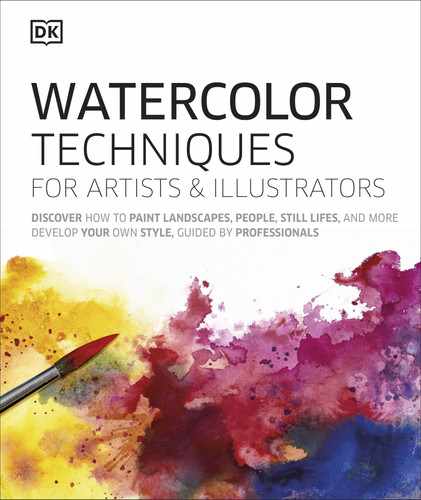
208 Patterns, still lifes, and flowers | SUBJECTS
PUTTING IT INTO PRACTICE
For this still life of rusty and
mossy objects, grainy pigment
represents the aged surface, with
saturated salt applied to add real
surface texture. Dry brush marks
contrast with smooth blends.
Aged surfaces
FOCUSING ON TEXTURE
The appeal of painting still lifes is that you can select your subject matter, bringing
together objects that have a common theme. When focusing on texture, draw on
different techniques to produce a painting that is visually exciting, with sedimentary
pigments, granulation medium, and salt to convey your subject without painstakingly
painting every detail. Use these methods for many subjects, from metal to fur.
Patinated textures
No. 18, no. 10, and no. 6 soft-hair
round brushes
Granulation medium
Salt wash of 50:50 salt to water
10
1
⁄2 x 15 in (26 x 38 cm) rough
140 lb (300 gsm) watercolor paper
You will need
1
Highlight underpainting
Paint the highlights that you want
to retain, using large, transparent,
overlapping washes for the brightest
surfaces. For the rusted edges, use
dry brush marks (see pp.56–57) and
granulating pigments such as cobalt to
introduce texture. Mix green and violet
granulating pigments for the algae effect.
2
Encourage granulation
When the underpainting is dry, apply
a wash of clear granulation medium over
the areas of algae. While still wet, add
granulating pigments with more medium,
painting with a loaded brush at a vertical
angle. Encourage rivulets to run freely.
Lunar blue
Shadow
violet
Green apatite
genuine
Piemontite
genuine
Cerulean
blue
Cobalt
blue
Ultramarine
blue
Cobalt
turquoise
light
Burnt
sienna
Cadmium
red
Lemon
yellow
Granulating
US_208-209_Still_life_2.indd 208 02/04/2020 3:35pm

209 Aged surfaces
Controlling textures
By combining granulating pigments (see
pp.90–91) with granulation medium or salt,
you can intensify or manipulate the effects
to create some unique patterns, such as free
owing rivulets. Plan your palette to include
pigments that separate, and match them to
your subject and the textures that you wish
to convey. A salt wash attracts pigment to
look grainy, which differs to the light,
mottled effects of using dry salt (see p.148).
3
Apply salt wash
Once your rivulets have dried, scoop
up a thick quantity of saturated salt
onto your brush and apply it with the
salt water to the rusty areas. Quickly
add plenty of burnt sienna in blobs to
this area; it will appear lighter as the
pigment is drawn to the salt grains.
4
Smooth contrasts
While working on the rusty texture,
keep other parts smooth for contrast,
working wet-on-dry for the lamp base.
Add the background, keeping the
textures simple in order not to detract
from the main focal points.
The texture of the rough
paper holds pigment that
adds to the overall effect
Rivulets and runs
Apply granulation medium to the
underpainting. Then slowly dribble
granulation medium and granulating
pigments down the surface for rivulets.
Salt wash
Mix 50:50 salt and water and apply as a
clear wash. Drop strong pigment into the
wash before it dries. The pigment and
salt combine for a textured effect.
US_208-209_Still_life_2.indd 209 02/04/2020 3:35pm

Shadows and sunlight
See pp.138–139
Strong shadows—which are
colored, not just gray—with
dened edges, give depth
and a sense of three-
dimensional form, and
show the direction of light.
Using masking uid
See pp.100–101
Masking uid is very
effective at keeping small
areas and thin lines white,
which would otherwise be
impossible when painting
in watercolor.
Wet-on-dry
See pp.50–51
Using the wet-on-dry method
liberally gave the artist the
freedom to enhance areas
of the painting with
interesting visual textures
and brush marks.
Artist Michele Illing
Title Garlic, Lemons, and a Lime
Paper 16
1
⁄2 x 27 in (42 x 69 cm)
cold press 140 lb (300 gsm)
watercolor paper
US_210-211_Still_life_showcase_Michele.indd 210 02/04/2020 3:35pm
..................Content has been hidden....................
You can't read the all page of ebook, please click here login for view all page.
